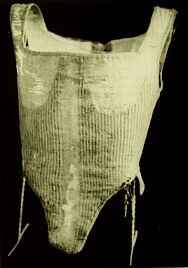Dressing From the Inside Out
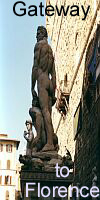   |
by La Signora Onorata Katerina da Brescia
Possibly the hardest thing I find to do when contemplating new garb, is to slow down.... The temptation is there to do directly into creating that 'dream gown' but it does not look the same if it does not have the correct foundations. So what I am trying to do is to create an outfit, not just a costume. This is best done by starting with the concept, then the underwear and underclothes, the gown itself, any outer clothing and then (well usually I do this bit along the way) the accessories. And how I love accessories! I must admit, I have made a few outfits to match accessories to die for but the actual clothing works (and looks) best if made from the inside out. The Concept:
Why do I consider this part of dressing inside out. Well, the concept starts in the mind - the brain - and that is an internal thing.. (yeah, yeah...) But researching an outfit and coming up with the concept helps me decide what I want and formualte a plan on what needs to be done to give the correct look - what steps to go through. Firstly, I look at usually 40 or more portraits before I find one that inspires me. Sometimes it is just one! Next I try to find other portraits similar either in look, time period and place. Hopefully I can come up with at least 2-4 more. Then I go looking to see if there is any current research in the area. Don't forget books on sumptuary laws (this gives an idea on who wore what and what existed when, as well as where things came from). Books I reach for first, for Italian or Elizabethan garb, are:
Though the web is ephemeral and some sites
are not well researched, there are some that are of good value with
documented evidence and bibliographies or links that can be very
helpful.
Books good for help on construction are:
Websites good for construction are:
Underwear:
Even starting at the beginning, there is debate. Camicias: See my article on Shirts and Camicias. Also known as smocks, chemises or shirts (men mainly). These were worn under the gowne, keeping both the wearer and the gowne protected. They are usually made of linen or silk and can be very decorative. Camicias,or chemises, are an obvious addition to the wardrobe of the Renaissance gentle. They can be seen in almost any portrait. But what of drawers? Drawers: Extant examples of women's drawers can be found in
Queen Elizabeth's Wardrobe Unlock'd
and A History of Underclothes has an Italian extant example. Both appear to be from
the late 16th century. Pictorial representations such as Pierto
Bertelli's Cortigiana
Veneza (Venetian courtesan) can be
found in Diversarum Nationum
Habitus , 1591 (V&A Museum)
& 1594-1596 ( Banca dati
Biblioteca Riccardiana ). There are
many examples of braies for men, in many illuminations and paintings.
Alas, for women, there is less documentary evidence that I have been
able to find. 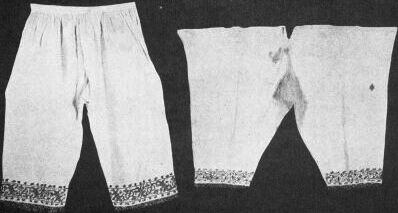 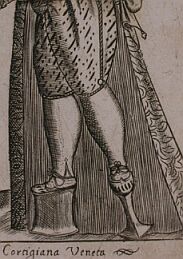 Petticoats/Skirts: Depending on yoru geographical area and time period of interest, this varies. I have found little evidence of the use of farthingales in 'most' of the Italian fashions, especially in the 1500's-40's which I prefer. Looking at contemporary portraits (particularly those where the sitter is actually sitting) it appears that Italians favoured large underskirts or petticoats to give fullness to their outfits. These were often contrasting and could be decorated at the hem. Some portraits show the overskirt being pulled up with a belt, to reveal the underskirt. Examples, showing folds of overskirts not possible with farthingales and visible underskirts include:
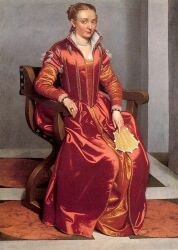 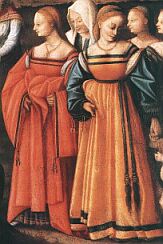 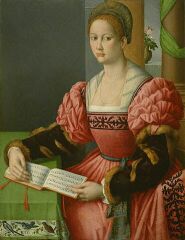 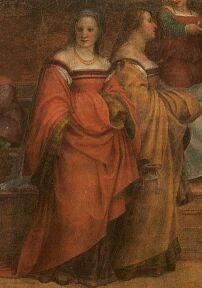 
Italian skirts did not have the rigid 'A' line of the Elizabethan fashion, at least until very late in the 16th century, and only in some areas. Elizabethan 16th century Spanish garb used farthingales. These were petticoats that were stiffened petticoats, often in a 'A' line shape, to hold the skirts out. Traditionally they could be stiffened with rope or willow bents. This could be tied to the corset which is used to create the silhouette in this fashion.
Underwear
Accessories: eg. bumrolls are a
sausage shaped pad worn under the dress to give a more prominent
backside. This is more common in later 16th century and more
Elizabethan than Italian.
Stockings: Extant examples of bias cut (English) stockings are
from Queen Elizabeth's Wardrobe
Unlock'd - and knitted (Italian)
stockings is from A History of
Knitting and belonged to Eleanora of
Toledo. Both are from the second half of the 16th century. Bias cut
stockings are recorded as being made from wool, sarcenet, silk,
linen, flannel. Seams were at the back of the calf. Textiles and Clothing (p. 186) gives evidence of bias cut stockings and hose
in 14th century extant finds. It also gives details on how they were
made, including seam types and stitch lengths.
Overthings:
Now onto the things that can actually be seen! This is usually the subject of most garb diaries seen on the internet. Options are too varied to discuss in summary here. I would point you to the good books I mentioned up first, then again to contemporary portraits, finally there are many good websites with garb diaries that may help you. It is very interesting to look at websites, even 'debatable' ones, as you may find that someone has found an answer to a construction problem you have, or may have done a blatantly wrong thing you can avoid. All can be an educational benefit.
Accessories:
Again, the list is so varied. A short list is as follows (A longer article on this subject will follow at a later date and is currently available on Innilgard's A&S Collegium CD 3 - 2004). The trick is to try to make your accessories match the time and place of your outfit. The best way to do this is to look at contemporary portraits and see what they wore.
Bibliography:
Various contemporary portraits and websites
as mentioned above. |
    |
All intellectual content, photos and layout are copyright to La Signora Onorata Katerina da Brescia (K Carlisle), except those original renaissance artworks and extant articles whose copyright remains with the current owner.
